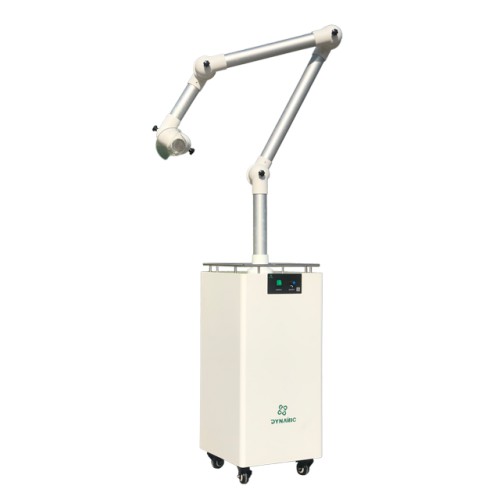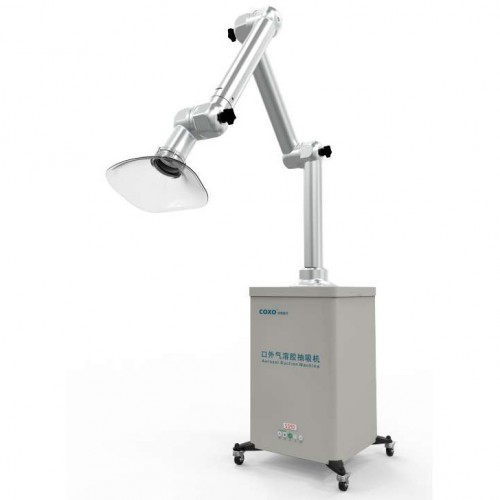What to Look for in an aerosol suction unit
You will find all kinds of portable aerosol suction system or extaoral suction unit in the market this year. You might want to know how to find a right one for your office. We’ve assembled a list of things to consider when searching for an aerosol suction unit to fit in your office…
Suction power- should we look at motor power (watts), pressure rating or airflow rate?
The customers want a machine with high suction power to capture as much aerosol as possible. So what does it mean high suction power? Which number on the product specs should we compare among different models? The short answer is bigger motor or higher pressure doesn’t guarantee the equipment can take more aerosol than a smaller unit. The number really matters to us is the airflow rate (or volume flow), which is calculated by multiplying air velocity by the cross section area of a suction duct/pipe. It can be translated to ACH (air changes per hour) in OSHA standard, meaning the number of times air is replaced in an hour. Volume flow is usually measured in Cubic Feet per Minute (CFM).Higher airflow (CFM) also means high face velocity from the suction hood and higher velocity pressure (suction power) in the pipe.

Let’s compare product A (1000 Watt) and product B (200 Watt) in the picture below. The negative pressure at fan inlet is claimed at -25kPa for product A, while the negative pressure at fan inlet is 3kPa for product B. However, both airflow is rated at 150CFM. What would you choose? Should we choose the higher suction pressure?

The most important factor is how much air with aerosol can be sucked into the system. In other words, how fast the polluted air around dentist’s operation area can be replaced with HEPA filtered clean air. Same airflow rate means the same face velocity and air movement from the suction hood. If the airflow is the same, bigger motor and high pressure may only indicate less efficiency design, higher noise level (db) or higher utility cost to the office. That’s why OSHA and ASHRAE ventilation standard 62.1 gives specific ACH (air exchange per hour) requirements for different space types instead of using motor horsepower or fan inlet pressure.
You should be also careful about the number claimed on the manufacturer’s specs. For example, a product was claimed suction power of 4000 L/min (141CFM) air volume and 25kPa pressure, which is equal to 100 in. water gauge pressure. You may ask your engineer friend if a 1,000Watt fan can provide 100 inch pressure in real world. Here’s a simple calculation for fan power: required fan power= 141CFM*100 in./(100%*6356)=2.21HP=1,653Watt- this is the power needed with a 100% fan efficiency (which is impossible). Now we find the over-claim in this specs.

Air Filtering Standard: Why HEPA? HEPA stands for High Efficiency Particulate Air. It is a standard defined and developed by the U.S. Department of Energy during the 1940s as part of their efforts to contain the spread of particles and contamination resulting from nuclear testing. This standard has since moved into the consumer market and has become commonplace for medical grade filtration.
True HEPA generally ranges from H10-H12. This is the “grade” of HEPA or the level of efficiency. The higher the grade, the better the filter. HEPA H13-H14 are within the highest tier of HEPA and are considered medical grade quality. Whereas H10-H12 filters only trap 85-99.5% of all particles that are 0.1 microns in diameter, HEPA H13 and H14 trap 99.95% and 99.995% of such particles, respectively.
Medical grade HEPA filters are commonly used in pharmaceutical manufacturing and electronic control rooms because they have a greater particulate retention rate. This means medical grade HEPA filters are more efficient in removing harmful toxins and airborne with virus from the environment. And you can always upgrade your filter from H13 to H14 anytime.
CAUTION: HEPA Type and HEPA Like
Unlike True HEPA, “HEPA Type” and “HEPA Like” filters fail the standard. These terms are essentially meaningless and are used in order to confuse consumers into purchasing lower quality filters and air purifiers. While it is variable what percentage of particles these filters do remove, it is certain that they do not remove 99.97% of particles 0.3 microns in diameter. These filters are less dense and thus unable to trap the smallest and most harmful particles.
So, to answer one of the first questions: No – there are not different types of HEPA. There is either HEPA or NOT HEPA.
Noise Level: You want this to be as low as possible, but realize some of the high capacity aerosol suction units do make noise. Working in a noisy environment for a long time can be painful. Also make sure the unit come with speed adjustment function to lower the noise level if necessary.

Cost of Replacement Parts:
Find out what it costs to replace filters and other parts. Make sure it is easy to access the filter chamber. Do you want to pay extra for technician to do maintenance?
Electricity Costs: Know how much it costs to run an electronic air cleaner.
Comparison of a 200 Watt High Efficiency motor and 1800 Watt motor
The electricity cost is $0.15/kWh * 1800 hrs * (1.8-0.2) = $432 with assumption of 1800hr run time and utility rate at 0.15/kWh
Warranty: Learn about the warranty available for the unit you are considering. Normally the cosmetic and consumables are not covered in Warranty.
Indicator Lights or alarm for Filter Changes:
Some units have them. It’s not necessary, but is kind of convenient.
Multi-layer Filters: Does the unit have a pre-filter and middle layer of filter to increase HEPA filter efficiency? A pre-filter and middle layer filter can make the HEPA filter last longer with better efficiency.
Size and Look of the Aerosol suction unit: Some dental aerosol suction units are big and ugly. Others are sleek and pleasing to the eye.
Choice of suction duct/pipeSome people like the convenience of flexible duct. But many others prefer the better looking and sturdy aluminum arm. Based on our observation and experience, the flexible duct doesn’t last as long as the aluminum arm/pipe.
Tips on Selecting a Perfect Dental Extra-oral Vacuum Machine